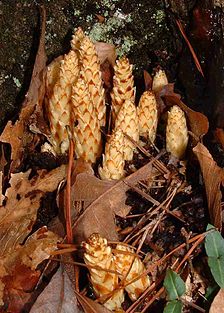
Also called American cancer-root, squawroot, and bumeh, this parasitic herbaceous perennial is native to eastern North America and is a member of the broomrape family, Orobanchaceae, that also includes Indian paintbrush, groundcones, and bird’s beak. The plants grow underground attached to the roots of oak or beech trees and emerge after about 4 years from spring into summer with a stout stem 2-8″ tall. The unbranched stem carries a dense spike of cream to golden yellow, tubular flowers that resemble a pine cone or cob of corn. The flowers have 4-5 petals, and are about 1/2″ long and downward facing. They open from the bottom of the spike to the top and give way to an elongated seed capsule containing many small seeds. As summer goes into fall the stems and flowers turn brown to black and wither, persisting into winter. There are no true leaves but small, ovate, brown scales appear at the base of the flowers. The plant is not green and does not carry out photosynthesis so derives its nourishment from the roots of oak or beech host tree where it forms knobby growths. The flowers are pollinated by bumblebees and flies; the stems, flowers, and seeds are eaten by mammals including white tailed deer and bear. Bear corn has been used as food and for treating female problems by native Americans. There is no evidence that his plant cures cancer and the common name, American cancer-root, may refer to the knobby growths on the host plant. The genus name, Conopholis, comes from the Greek words conos, meaning cone, and pholis, meaning scale . The specific epithet, americana, is the Latinized word referring to the geographic distribution of the plant.
Type: Parasitic herbaceous perennial
Bloom: Spikes of cream to yellow tubular flowers from spring into summer
Size: 2-8″ H x < 1″ W
Light: Very variable
Soil: Humusy, consistently moist, well-drained
Hardiness: Zones
Care: Low maintenance
Pests and Diseases:
Propagation: Seed
Companion Plants: Oak, Beech
Outstanding Selections: None available
Photo Credit: Wikipedia